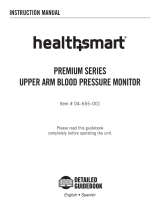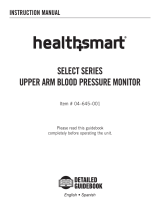Page is loading ...

Deluxe Wrist
Blood Pressure Monitor
WGNBPW-520
El manual
en español
empieza en la
página 42

1
TABLE OF CONTENTS
INTRODUCTORY INFORMATION:
Important Product Notices and
Safety Instructions .......................................... 3
About Blood Pressure ..................................... 6
What is Blood Pressure?
Why Measure Your Blood Pressure?
Blood Pressure Standard ................................ 7
How This Blood Pressure
Monitor Works .................................................. 8
USAGE INFORMATION:
Name/Function of Each Part ......................... 10
Display Explanations ..................................... 11
Installing Batteries ........................................ 13
Date & Time Set Procedure ........................... 15
Applying the Cuff ........................................... 16
Correct Measurement Posture ..................... 18
Measurement Procedure ............................... 20

2
Risk Category Index ...................................... 25
Irregular Heartbeat Detector (IHB) .............. 26
Recalling Values from Memory ..................... 28
Clearing Values from Memory ...................... 30
Important Notes Regarding Your
Blood Pressure Measurement ...................... 31
Care, Maintenance & Cleaning ..................... 33
Potential for Electromagnetic
Interference .................................................... 35
Troubleshooting ............................................. 36
Specifications ................................................ 37
5 Year Limited Warranty ................................ 39

3
IMPORTANT PRODUCT NOTICES AND
SAFETY INSTRUCTIONS
When using your blood pressure monitor, basic
precautions should always be followed. Please
read and follow all instructions and warnings before
using this product. Save these instructions for future
reference.
• Pleasenotethatthisisahomehealthcare
product only and it is not intended to serve as
a substitute for the advice of a physician or
medical professional.
• Donotusethisdevicefordiagnosisortreatment
of any health problem or disease. Measurement
results are for reference only. Consult a
healthcare professional for interpretation of
blood pressure measurements. Contact your
physician if you have or suspect any medical
problem. Do not change your medications
without the advice of your physician or
healthcare professional.

4
• Thisproductisnotsuitableforpeoplewith
arrhythmias. This device may have difficulty
determining the proper blood pressure for
individuals with irregular heartbeat, diabetes,
poor circulation of blood, kidney problems or for
users who have suffered from a stroke.
• Consultyourphysicianbeforemeasuring
blood pressure at the wrist if you have any of
the following conditions: Severe hypertension,
severe diabetes, severe arteriosclerosis, severe
kidney disease or vascular disease that may
compromise circulation.
• Thepulsedisplayisnotsuitableforcheckingthe
frequency of heart pacemakers.
• Electromagneticinterference:Thedevicecontains
sensitive electronic components. Avoid strong
electrical or electromagnetic fields in the direct
vicinity of the device (e.g. mobile telephones,
microwave ovens). These may lead to temporary
impairment of measurement accuracy.
• Usebloodpressuremonitoronlyforitsintended
use.

5
• Donotwrapthecuffaroundbodypartsother
than your wrist.
• Notforusebyoronpersonsunderthe
age of 18.
• Useonly1.5VAAAalkalinebatteriesforpower
supply.
Blood pressure measurements determined with
this device are equivalent to those obtained by
a trained observer using the cuff/stethoscope
auscultatory method, within the limits prescribed by
the American National Standard, Manual, electronic,
or automated sphygmomanometers.

6
ABOUT BLOOD PRESSURE
What is Blood Pressure?
Blood pressure is the pressure exerted on the artery
walls while blood flows through the arteries. The
pressure measured when the heart contracts and
sends blood out of the heart is systolic (highest)
blood pressure. The pressure measured when the
heart dilates with blood flowing back into the heart
is called diastolic (lowest) blood pressure.
Why Measure Your Blood Pressure?
Among today’s various health problems, those
associated with high blood pressure are very common.
High blood pressure dangerously correlates with
cardiovascular diseases. Therefore, blood pressure
monitoring is important for identifying those at risk.

7
BLOOD PRESSURE STANDARD
The table below is criteria for hypertension that is publicly
available from the National Heart Lung and Blood Institute at
the U.S. National Institutes of Health (NIH) (http://www.nhlbi.
nih.gov/health/dci/Diseases/Hbp/HBP_WhatIs.html). Users
can compare their own blood pressure readings against these
established criteria to determine if they may be potentially at
increased risk.
This table is applicable to most adults aged 18 and older.
Blood pressure tends to go up and down, even in people who
normally don’t have high readings. If your numbers stay above
the “normal” range most of the time, you may be at increased
risk and should consult your physician.
Although one can easily find where their own blood pressure
readings fall on this table, this monitor comes equipped with
a Risk Category Index that automatically compares each
reading to this criteria and provides a helpful cue if your
Category
Systolic (mmHg)
Diastolic (mmHg)
Normal Less than 120 And Less than 80
Prehypertension 120-139 Or 80-89
High Blood Pressure
Stage 1 140-159 Or 90-99
Stage 2 160 or higher Or 100 or higher

8
BLOOD PRESSURE STANDARD
The table below is criteria for hypertension that is publicly
available from the National Heart Lung and Blood Institute at
the U.S. National Institutes of Health (NIH) (http://www.nhlbi.
nih.gov/health/dci/Diseases/Hbp/HBP_WhatIs.html). Users
can compare their own blood pressure readings against these
established criteria to determine if they may be potentially at
increased risk.
This table is applicable to most adults aged 18 and older.
Blood pressure tends to go up and down, even in people who
normally don’t have high readings. If your numbers stay above
the “normal” range most of the time, you may be at increased
risk and should consult your physician.
Although one can easily find where their own blood pressure
readings fall on this table, this monitor comes equipped with
a Risk Category Index that automatically compares each
reading to this criteria and provides a helpful cue if your
reading falls into one of the stages that could potentially
indicate increased risk. See page 25 for more information on
this feature.
Please note that cues provided by this monitor are only
intended to assist you in using this table. The table and
cues are only provided for convenience to have access to
the NIH information. They are not a substitute for a medical
examination by your physician. It is important for you to
consult with your physician regularly. Your physician will tell
you your normal blood pressure range as well as the point at
which you may actually be considered to be at risk.
HOW THIS BLOOD PRESSURE
MONITOR WORKS
This monitor uses innovative technology to detect your
blood pressure. This technology enables the monitor to
automatically inflate and deflate to the appropriate level for
each individual. With one touch of a button, the cuff will
automatically inflate to block the blood flow through your
artery. Next, the deflation process starts.
Please note that any muscle movement during inflation or
deflation will cause measurement error. When measurement
is complete, the monitor will display your systolic pressure,
diastolic pressure, and pulse readings.
Category
Systolic (mmHg)
Diastolic (mmHg)
Normal Less than 120 And Less than 80
Prehypertension 120-139 Or 80-89
High Blood Pressure
Stage 1 140-159 Or 90-99
Stage 2 160 or higher Or 100 or higher

9
The monitor automatically finds where your
measurement results fall on the NIH’s National Heart
Lung and Blood Institute’s table and provides a cue
if your reading falls into one of the stages that could
potentiallyindicateincreasedrisk.Seepage25for
more information on this feature.
The appearance of the icon indicates that a
pulse irregularity consistent with an irregular heartbeat
was detected during measurement. Refer to page
26 for more information on the Irregular Heartbeat
Detector.

10
NAME/FUNCTION OF EACH PART
Accessories for unit :
2“AAA”size,1.5Valkaline
batteries included in the
carrying case with the unit.
Memory Recall
Button
User-Select
Button
Wrist Cuff
Battery Cover
START/STOP
Button
Date/Time
Set Buttons
LCD Display

11
DISPLAY EXPLANATIONS
Systolic
Pressure
Diastolic
Pressure
Date/Time Indicator
Pulse Rate

12
Display Symbols:
User 1: Appears when the monitor is operated by
User 1
User 2: Appears when the monitor is operated by
User 2
Weak Battery Symbol: Appears when batteries
should be replaced
Pulse Symbol: Shows the pulse rate per minute
Irregular Heartbeat Detector: Refer to page 26 for
more information.
Memory Average: Displays average of last 3
readings
Risk Category Index:Seepage25formore
information
Measurement Error: Measure again. Wrap
the cuff correctly and keep wrist steady during
measurement.
Air Circuit Abnormality: Measure again.
Pressure Exceeding 300 mmHg: Switch the unit
off to clear, then measure again.
Error Determining Measurement Data: Measure
again.
If and any of the following letters and numbers
appear in the area that systolic pressure should be
displayed, an error has occurred with your reading.
See Troubleshooting section of this manual for more
information.
/
START
STOP
M
(No Symbol)

13
INSTALLING BATTERIES
1. The battery cover is located
along the bottom side of the
monitor. Remove battery cover
by pressing down and pulling
away from the monitor.
2. Install batteries according to
the polarity indications inside
the compartment (as shown
in figure 2). Battery Type: 2
Alkaline LR03 (AAA) size
3. Insert the other battery,
according to the polarity
indications inside the
compartment (as shown in
figure 3).
4. Replace the cover by inserting
it back into place.
1.
3.
4.
2.

14
Replace the batteries if:
1. The weak battery symbol appears in the display.
2. Nothing appears in the display when the power is
switched on.
As the supplied batteries are for test only, they may
be discharged earlier than batteries you buy in stores.
Replace all batteries at one time (as simultaneous set).
Useonly1.5VAAAalkalinebatteries.Removebatteries
when unit is not in use for extended periods of time.
Date and time will need to be reset if batteries are
removed or replaced. Clean contacts on battery and
in battery compartment with a soft dry cloth each time
you install batteries.
Note: Batteries are hazardous waste. Do not dispose
of them together with the household garbage.

15
DATE & TIME SET PROCEDURE
1. To adjust the date/time, press the Set button
located on the top of the monitor.
2. The display will show a blinking number showing
the HOUR. Change the HOUR by pressing the
button. Each press will increase the number
by one in a cycling manner. Press the Set button
again to confirm the entry, and the screen
will show a blinking number representing the
MINUTE.
3. Change the MONTH, DAY and YEAR as
described in Step 2 above, using the
button
to change the numbers and the Set button
to confirm the entries.
Press the button
blinking HOUR
increasing HOUR
confirm the entry
repeat process to set MINUTE,
MONTH, DAY and YEAR

16
APPLYING THE CUFF
1. Remove all watches, wrist jewelry, etc. prior to
attaching the wrist monitor. Clothing sleeves
should be rolled up and the cuff should
be wrapped around bare skin for correct
measurements.
2. Apply cuff to left wrist with
palm facing up as shown in
Fig. A.
3. Make sure the edge of the
cuff is about 1/4”~1/2” (1 cm)
from the palm as shown in
Fig. B.
Fig. A
Fig. B

17
4. In order to insure accurate
measurements, fasten the
hook and loop strap securely
around your wrist so there is
no extra space between the
cuff and the wrist as shown
in Fig. C. If the cuff is not
wrapped tight enough, the
measurement values will not
be accurate.
5.Ifyourphysicianhas
diagnosed you with poor
circulation in your left arm,
place the cuff around your
right wrist as shown in Fig. D.
Fig. C
Fig. D

18
CORRECT MEASUREMENT POSTURE
1. Place your elbow on a table
so that the cuff is at the same
level as your heart as shown in
Fig. A. Relax your entire body,
especially between your elbow
and fingers.
Note: Your heart is located
slightly below your armpit.
2. If the cuff is not at the same
level as your heart or if
you cannot keep your arm
completely still throughout the
reading, use a soft object such
as a folded towel to support
your arm as shown in Fig. B.
Fig. A
Fig. B

19
3. Turn your palm upwards.
4. Sit upright in a chair, and
take5-6deepbreaths.
Avoid leaning back while
the measurement is being
taken as shown in Fig. C.
Fig. C
(X)
/

